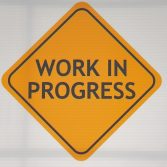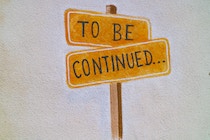
20/09/2023
The agency website: five top tips for greater impact
By Jonathan Kirk, Founder, Up to the Light and DBA Expert
As you’d expect, most design agency websites tend to be generally well designed, glossy even, compared to many other sectors.
According to clients, however, where agency websites often fall down is around the messaging. We know from our ‘What Clients Think’ report that 66% of clients state that agencies are failing to answer the question ‘Why us rather than another agency?’ in new business situations and nowhere is this truer than the website.
The agency website can be a frustrating subject. I’ve lost count of the agency managing directors who have said to me, ‘Don’t look at our website. It’s not really representative of who we are and our current offer.’ The website is a job that’s never completed and it’s best to think of it as akin to a living organism – constantly evolving, never standing still. So, whether you’re looking to completely reassess your website or just sharpen it, these 5 thoughts might help:
1. This is serious
 When it comes to our own websites, agencies are frequently guilty of starting with the styling, not the message. Exactly the type of thing we warn clients against. It can quickly become a one-dimensional creative project that people get excited about in the studio, rather than a brand positioning and design project. The website can be a great vehicle for re-thinking the agency’s difference. So, before a creative gets near the website, get the thinking right. Research what clients are looking for, review your competitors’ sites, run a workshop to look at some key questions. Who are we, what do we do, how do we do it and why do we do it are very simple questions, but they can be incredibly difficult to answer. Do all those things that you’d normally do for a client project that can easily fall by the wayside for an internal project. Treat it with the same rigour.
When it comes to our own websites, agencies are frequently guilty of starting with the styling, not the message. Exactly the type of thing we warn clients against. It can quickly become a one-dimensional creative project that people get excited about in the studio, rather than a brand positioning and design project. The website can be a great vehicle for re-thinking the agency’s difference. So, before a creative gets near the website, get the thinking right. Research what clients are looking for, review your competitors’ sites, run a workshop to look at some key questions. Who are we, what do we do, how do we do it and why do we do it are very simple questions, but they can be incredibly difficult to answer. Do all those things that you’d normally do for a client project that can easily fall by the wayside for an internal project. Treat it with the same rigour.
2. View it through a client’s eyes
 88% of clients want a website to quickly show them what an agency is best at. With so many agencies offering so many services, this can be difficult. Nailing and articulating how and where you excel is crucial. Remember that this isn’t necessarily a particular service. It can equally be the way you think or the way you approach challenges. In a new business context, clients need fast extraction of useful information. In other words, they are looking for speedy answers to questions such as what the agency is best at, do they have relevant experience that fits the client’s strategic challenges and what would they be like to work with? 59% of clients stated an increased need for creative work to demonstrate a return on investment, so clearly flagging up your work’s commercial effectiveness is always powerful. Above all, never lose sight of your website’s main purpose. It’s really about whetting the client’s appetite enough that they might want to meet you. Primarily, the website is there to sell a meeting. We need to make it easy for them. Clear and compelling messaging is key.
88% of clients want a website to quickly show them what an agency is best at. With so many agencies offering so many services, this can be difficult. Nailing and articulating how and where you excel is crucial. Remember that this isn’t necessarily a particular service. It can equally be the way you think or the way you approach challenges. In a new business context, clients need fast extraction of useful information. In other words, they are looking for speedy answers to questions such as what the agency is best at, do they have relevant experience that fits the client’s strategic challenges and what would they be like to work with? 59% of clients stated an increased need for creative work to demonstrate a return on investment, so clearly flagging up your work’s commercial effectiveness is always powerful. Above all, never lose sight of your website’s main purpose. It’s really about whetting the client’s appetite enough that they might want to meet you. Primarily, the website is there to sell a meeting. We need to make it easy for them. Clear and compelling messaging is key.
3. Case studies – keep them short
 Most clients don’t have the time or inclination to wade through dense case studies on your website. 91% of clients prefer agency websites with less copy, so keep them short and concise. It’s more about sharp, pithy statements and a visual story. There are two other reasons for keeping case studies ruthlessly short. Firstly, if you’ve already told the detailed story of the project, what are you going to tell them when you meet? Secondly, agencies need to tell client stories differently, depending on who you are talking to. Keeping web case studies short gives you the flexibility to do this when you actually meet the potential client. The days of having a pre-prepared bank of case studies, applicable to multiple potential clients, should be over. We’re not librarians. Instead, the modern agency should be a curator of case studies, re-engineering case studies to be pinpoint relevant to a particular client and the strategic issues they are facing.
Most clients don’t have the time or inclination to wade through dense case studies on your website. 91% of clients prefer agency websites with less copy, so keep them short and concise. It’s more about sharp, pithy statements and a visual story. There are two other reasons for keeping case studies ruthlessly short. Firstly, if you’ve already told the detailed story of the project, what are you going to tell them when you meet? Secondly, agencies need to tell client stories differently, depending on who you are talking to. Keeping web case studies short gives you the flexibility to do this when you actually meet the potential client. The days of having a pre-prepared bank of case studies, applicable to multiple potential clients, should be over. We’re not librarians. Instead, the modern agency should be a curator of case studies, re-engineering case studies to be pinpoint relevant to a particular client and the strategic issues they are facing.
4. Punch above your weight
 22% of clients believe that some agency websites defy credibility – ‘Can an agency of 15 people really deliver that long list of services? How on earth are they able to monitor global trends?’ Clearly, you need to avoid hype and over claim, but remember that the agency website is an opportunity to set out your stall for the future. It’s aimed at the clients you want to attract, the types of project you want to win. For small/medium sized agencies, the website is often an opportunity to punch above your weight. So, think about the messages that support that and which messages might detract. For instance, overly humorous people profiles can easily convey your agency as small. Do you show everyone in the agency or just ‘key people’? Does segmenting your work by industry sectors merely show up the gaps in your experience? Is your website just a glorified portfolio with additional news, or are you sharing an authentic viewpoint?
22% of clients believe that some agency websites defy credibility – ‘Can an agency of 15 people really deliver that long list of services? How on earth are they able to monitor global trends?’ Clearly, you need to avoid hype and over claim, but remember that the agency website is an opportunity to set out your stall for the future. It’s aimed at the clients you want to attract, the types of project you want to win. For small/medium sized agencies, the website is often an opportunity to punch above your weight. So, think about the messages that support that and which messages might detract. For instance, overly humorous people profiles can easily convey your agency as small. Do you show everyone in the agency or just ‘key people’? Does segmenting your work by industry sectors merely show up the gaps in your experience? Is your website just a glorified portfolio with additional news, or are you sharing an authentic viewpoint?
5. Allow clients to get under the skin
 We all want to know more about people and organisations more quickly. What really makes the agency tick? This is the agency story, the emotional part of the sell. Also, what’s your view on the world? What are your beliefs? Go beyond the standard ‘About us’ – reveal yourself. Answer the question, ‘Would I want to meet these people?’
We all want to know more about people and organisations more quickly. What really makes the agency tick? This is the agency story, the emotional part of the sell. Also, what’s your view on the world? What are your beliefs? Go beyond the standard ‘About us’ – reveal yourself. Answer the question, ‘Would I want to meet these people?’

 When it comes to our own websites, agencies are frequently guilty of starting with the styling, not the message. Exactly the type of thing we warn clients against. It can quickly become a one-dimensional creative project that people get excited about in the studio, rather than a brand positioning and design project. The website can be a great vehicle for re-thinking the agency’s difference. So, before a creative gets near the website, get the thinking right. Research what clients are looking for, review your competitors’ sites, run a workshop to look at some key questions. Who are we, what do we do, how do we do it and why do we do it are very simple questions, but they can be incredibly difficult to answer. Do all those things that you’d normally do for a client project that can easily fall by the wayside for an internal project. Treat it with the same rigour.
When it comes to our own websites, agencies are frequently guilty of starting with the styling, not the message. Exactly the type of thing we warn clients against. It can quickly become a one-dimensional creative project that people get excited about in the studio, rather than a brand positioning and design project. The website can be a great vehicle for re-thinking the agency’s difference. So, before a creative gets near the website, get the thinking right. Research what clients are looking for, review your competitors’ sites, run a workshop to look at some key questions. Who are we, what do we do, how do we do it and why do we do it are very simple questions, but they can be incredibly difficult to answer. Do all those things that you’d normally do for a client project that can easily fall by the wayside for an internal project. Treat it with the same rigour. 88% of clients want a website to quickly show them what an agency is best at. With so many agencies offering so many services, this can be difficult. Nailing and articulating how and where you excel is crucial. Remember that this isn’t necessarily a particular service. It can equally be the way you think or the way you approach challenges. In a new business context, clients need fast extraction of useful information. In other words, they are looking for speedy answers to questions such as what the agency is best at, do they have relevant experience that fits the client’s strategic challenges and what would they be like to work with? 59% of clients stated an increased need for creative work to demonstrate a return on investment, so clearly flagging up your work’s commercial effectiveness is always powerful. Above all, never lose sight of your website’s main purpose. It’s really about whetting the client’s appetite enough that they might want to meet you. Primarily, the website is there to sell a meeting. We need to make it easy for them. Clear and compelling messaging is key.
88% of clients want a website to quickly show them what an agency is best at. With so many agencies offering so many services, this can be difficult. Nailing and articulating how and where you excel is crucial. Remember that this isn’t necessarily a particular service. It can equally be the way you think or the way you approach challenges. In a new business context, clients need fast extraction of useful information. In other words, they are looking for speedy answers to questions such as what the agency is best at, do they have relevant experience that fits the client’s strategic challenges and what would they be like to work with? 59% of clients stated an increased need for creative work to demonstrate a return on investment, so clearly flagging up your work’s commercial effectiveness is always powerful. Above all, never lose sight of your website’s main purpose. It’s really about whetting the client’s appetite enough that they might want to meet you. Primarily, the website is there to sell a meeting. We need to make it easy for them. Clear and compelling messaging is key. Most clients don’t have the time or inclination to wade through dense case studies on your website. 91% of clients prefer agency websites with less copy, so keep them short and concise. It’s more about sharp, pithy statements and a visual story. There are two other reasons for keeping case studies ruthlessly short. Firstly, if you’ve already told the detailed story of the project, what are you going to tell them when you meet? Secondly, agencies need to tell client stories differently, depending on who you are talking to. Keeping web case studies short gives you the flexibility to do this when you actually meet the potential client. The days of having a pre-prepared bank of case studies, applicable to multiple potential clients, should be over. We’re not librarians. Instead, the modern agency should be a curator of case studies, re-engineering case studies to be pinpoint relevant to a particular client and the strategic issues they are facing.
Most clients don’t have the time or inclination to wade through dense case studies on your website. 91% of clients prefer agency websites with less copy, so keep them short and concise. It’s more about sharp, pithy statements and a visual story. There are two other reasons for keeping case studies ruthlessly short. Firstly, if you’ve already told the detailed story of the project, what are you going to tell them when you meet? Secondly, agencies need to tell client stories differently, depending on who you are talking to. Keeping web case studies short gives you the flexibility to do this when you actually meet the potential client. The days of having a pre-prepared bank of case studies, applicable to multiple potential clients, should be over. We’re not librarians. Instead, the modern agency should be a curator of case studies, re-engineering case studies to be pinpoint relevant to a particular client and the strategic issues they are facing. 22% of clients believe that some agency websites defy credibility – ‘Can an agency of 15 people really deliver that long list of services? How on earth are they able to monitor global trends?’ Clearly, you need to avoid hype and over claim, but remember that the agency website is an opportunity to set out your stall for the future. It’s aimed at the clients you want to attract, the types of project you want to win. For small/medium sized agencies, the website is often an opportunity to punch above your weight. So, think about the messages that support that and which messages might detract. For instance, overly humorous people profiles can easily convey your agency as small. Do you show everyone in the agency or just ‘key people’? Does segmenting your work by industry sectors merely show up the gaps in your experience? Is your website just a glorified portfolio with additional news, or are you sharing an authentic viewpoint?
22% of clients believe that some agency websites defy credibility – ‘Can an agency of 15 people really deliver that long list of services? How on earth are they able to monitor global trends?’ Clearly, you need to avoid hype and over claim, but remember that the agency website is an opportunity to set out your stall for the future. It’s aimed at the clients you want to attract, the types of project you want to win. For small/medium sized agencies, the website is often an opportunity to punch above your weight. So, think about the messages that support that and which messages might detract. For instance, overly humorous people profiles can easily convey your agency as small. Do you show everyone in the agency or just ‘key people’? Does segmenting your work by industry sectors merely show up the gaps in your experience? Is your website just a glorified portfolio with additional news, or are you sharing an authentic viewpoint? We all want to know more about people and organisations more quickly. What really makes the agency tick? This is the agency story, the emotional part of the sell. Also, what’s your view on the world? What are your beliefs? Go beyond the standard ‘About us’ – reveal yourself. Answer the question, ‘Would I want to meet these people?’
We all want to know more about people and organisations more quickly. What really makes the agency tick? This is the agency story, the emotional part of the sell. Also, what’s your view on the world? What are your beliefs? Go beyond the standard ‘About us’ – reveal yourself. Answer the question, ‘Would I want to meet these people?’